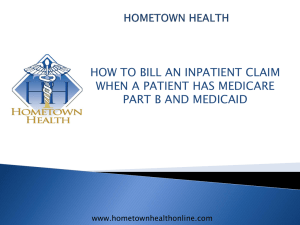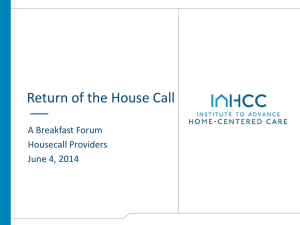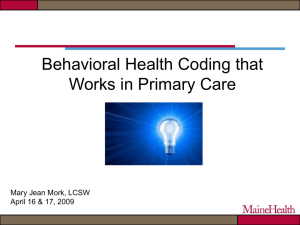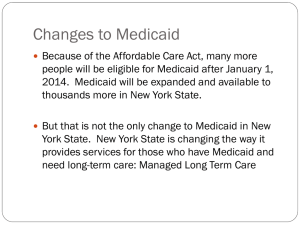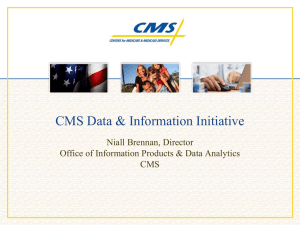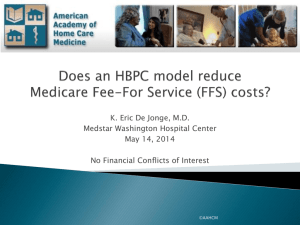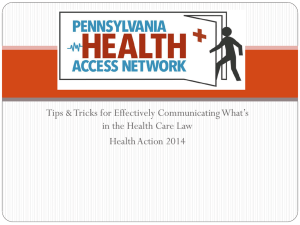Health Coverage and Care in the United States
advertisement
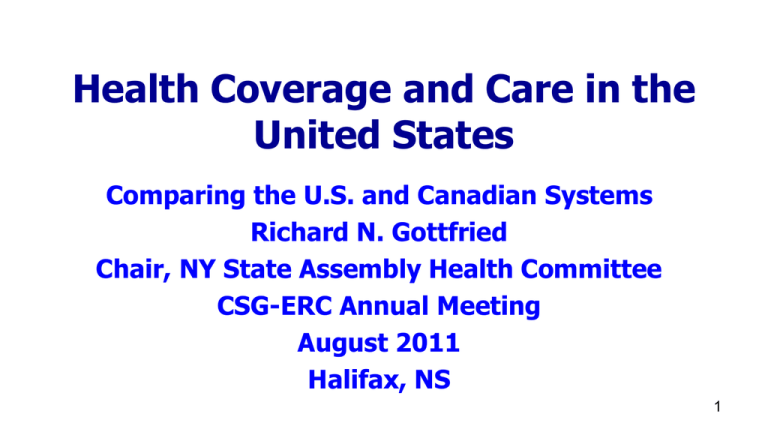
Health Coverage and Care in the United States Comparing the U.S. and Canadian Systems Richard N. Gottfried Chair, NY State Assembly Health Committee CSG-ERC Annual Meeting August 2011 Halifax, NS 1 “(T)he U.S. health system is not delivering superior results despite being more expensive, indicating opportunities for cross-national learning to improve health system performance.” The U.S. Health System in Perspective: A Comparison of Twelve Industrialized Nations, David A. Squires, Commonwealth Fund, July 2011 2 History Early 1800s – • U.S. decided: universal, free, public education is part of “public agenda” No one thought to add health care: • Health care was leeches, doctor with a saw, nurses to keep you comfortable while you die. • Not expensive. • Why would one turn to the government? 3 Then some things changed . . . Health care became: • Very effective • Very expensive Most world, including U.S.: • Using 3rd Party Payers • But: done very differently 4 Sources of U.S. Health Coverage Private & Public %’s overlap: • Some have 2 or more coverages 64% = Private (mainly employer) declining 31% = Public - growing • Medicaid: 15% • Medicare: 15% 17% = No coverage - growing 5 Source: DeNavas Walt, Carmen Bernadette D. Proctor, Jessica C. Smith: Income, Poverty and 6 Health Insurance Coverage in the United States:2009, U.S. Census Bureau, 2010 Private Coverage Insurance Co’s focus: • Earn dividends for stockholders • Charge as much as they can • Pay out as little as they can Employer’s focus: • Earn dividends for stockholders • Spend as little as possible Individual coverage • Hard to look at anything but price 7 Private Coverage Pressure = all downward: • Say “No” whenever possible • Pay as little as possible • Little incentive for investing in primary/preventive care: When it pays off -- you’ll be someone else’s customer 8 Public Coverage -- Medicaid “Programs for the poor tend to be poor programs” • Poor = not a powerful constituency Pressure = downward • Except perhaps for Major institutions Unionized 9 Public Coverage -- Medicare Covers all elderly, rich and poor • Not “for the poor” Pressure = balanced • Downward pressure – keep taxes down • Upward pressure: Powerful constituency Middle & upper income Medicare most popular part of system 10 Growth in Spending, 1969-2005, Medicare vs. Private Insurance Per Enrollee 3500% 3000% 2500% 2000% 1500% 1000% 500% 0% Medicare Private Insurance Source: David Himmelstein and Steffie Woolhandler, citing K. Levit, CMS, personal communication 11 And yet . . . “(T)he U.S. health system is not delivering superior results despite being more expensive, indicating opportunities for cross-national learning to improve health system performance.” The U.S. Health System in Perspective: A Comparison of Twelve Industrialized Nations, David A. Squires, Commonwealth Fund, July 2011 12 A lot more expensive . . . Dollars * 2007.13 Health Care Spending per Capita, 2008 Adjusted for Differences in Cost of Living Source: OECD Health Data 2010 (Oct. 2010). 13 …and the gap is widening Spending on Health, % of GDP, 1980–2008 Source: OECD Health Data 2010 (Oct. 2010). 14 Who pays? Employers Consumers • Share of premium • Out of pocket Taxpayers – 57% • Medicare, Medicaid & tax subsidy of employment-based coverage • Even more than in Canada 15 16 Why so expensive? Why isn’t all that downward pressure working? Not because we use more health care . . . 17 We use hospitals less Average Annual Hospital Inpatient Acute Care Days per Capita, 2008 2.0 1.6 1.6 1.2 1.1 1.0 1.0 0.9 0.9 0.8 0.8 0.8 0.7 0.7 0.6 0.4 0.0 GER SWIZ AUS** FR * 2007. 18 ** 2006. Source: OECD Health Data 2010 (Oct. 2010). CAN* OECD Median NOR UK NETH NZ US 18 We go to the doctor less Average Annual Number of Physician Visits per Capita, 2008 * 2007. 19 ** 2006. Source: OECD Health Data 2010 (Oct. 2010). 19 You might think we’re getting excellent results for what we’re paying. But we’re not. 20 “(T)he U.S. health system is not delivering superior results despite being more expensive, indicating opportunities for cross-national learning to improve health system performance.” The U.S. Health System in Perspective: A Comparison of Twelve Industrialized Nations, David A. Squires, Commonwealth Fund, July 2011 21 22 Years Life Expectancy at Birth, 2008 * 2007.23 Source: OECD Health Data 2010 (Oct. 2010). 23 Years Life Expectancy at Age 65, 2008 * 2007. ** 2006. 24 Source: OECD Health Data 2010 (Oct. 2010). 24 Administrative Costs Multiple health plans, each spending on • Marketing • Bureaucracy for saying “No” • Dividends to stockholders Health care providers • Dealing with multiple plans 25 26 27 28 Medicare & Medicare HMOs, Administration & Profit, % Administration 16 14 12 10 8 6 4 2 0 Profit 5.1 3.6 Traditional Medicare 9.2 Medicare Advantage Source: David Himmelstein and Steffie Woolhandler, citing GAO 6/24/2008 and National Health Account data for 2005 29 30 Needed Health Care Reforms • Payment reform that promotes: Primary & Preventive care Wellness, not Volume • Care coordination & management • Electronic records & systems 31 Needed Health Care Reforms Requires people with: • Stake in making improvements • Up-front investment • Authority/ability to lead 32 Interests are not always clear Health care providers • Paid fee-for-service (volume) Insurance industry • Raise premium 10% • Lose 5% of customers • Still ahead 4.5% 33 Federal Health Care Reform -- ACA Good programs to promote reform • Grants for Care coordination & “medical homes” – in Medicaid Electronic Health Records • Insurance market reforms No out-of-pocket for preventive care No pre-existing condition limits • Medicaid expansion • Insurance exchanges & premium subsidies 34 Federal Health Care Reform -- ACA Accountable Care Organizations – ACO’s • Integrated system of HC Providers Using payment reform, e.g.: Capitated payment from payer Pooling income from payers To shift resources to: Primary-preventive care Care coordination So all providers thrive by Controlling costs Improving outcomes 35 Still based in insurance system Multiple, competing payers • Little incentive to invest in change • No authority/ability to lead Each payer: limited impact Obstacles to working together • Legal • Business 36 Everything we need to do is much more difficult . . . . . . because of our system. 37 And don’t forget . . . Still have • Millions of Uninsured • Millions of Underinsured Grossly unfair funding • Premiums = regressive “tax” • Unrelated to ability to pay 38 Learn from other countries . . . “(T)he U.S. health system is not delivering superior results despite being more expensive, indicating opportunities for cross-national learning to improve health system performance.” The U.S. Health System in Perspective: A Comparison of Twelve Industrialized Nations, David A. Squires, Commonwealth Fund, July 2011 . . . no better place than Canada! 39 Physicians for a National Health Program pnhp.org Subscribe to: “Quote of the Day” Richard N. Gottfried Gottfried@nysa.us “The future is not a gift; it is an achievement.” Robert F. Kennedy 40

